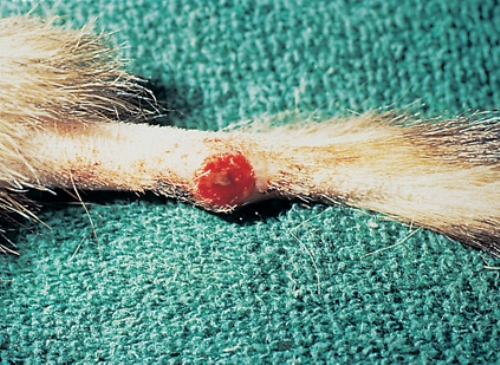Small Mammals Q&A 09
| This question was provided by Manson Publishing as part of the OVAL Project. See more Small Mammals questions |
A four-year-old ferret is experiencing thinning of the hair on the tail. Upon further inspection a raised, round, ulcerated lesion is noted midway down the length of the tail (the lesion is shown after the hair around it is removed). The owner reports that the ferret does not appear to be bothered by the lesion. The ferret is on a high quality commercial cat food diet and is otherwise clinically normal.
| Question | Answer | Article | |
| Is the thinning of the hair on the tail related to the lesion? | Not likely.
Partial to complete alopecia of the tail can occur in ferrets independent of any other skin lesions or clinical signs. The etiology is unknown. It usually appears at about the time of a normal hair molt. Hair regrowth usually occurs in one to three months. If the hair does not regrow, or if the hair loss progresses above the tail base, adrenal hyperplasia or neoplasia should be considered. |
Link to Article | |
| What are the differential diagnoses for skin masses in ferrets? | Neoplasia, enlarged lymph nodes and abscesses. Neoplasms that produce masses in or under the ferret’s skin include mast cell tumor or mastocytoma, sebaceous gland adenoma and adenocarcinoma, benign cystic adenomas, fibroma and fibrosarcoma, hemangioma, cutaneous hemangiosarcoma, chordoma, neurofibroma, leiomyoma, histiocytoma, squamous cell carcinoma, basal cell carcinoma, cutaneous lymphoma and melanoma.
It is possible to have more than one type of skin neoplasm present on an animal. The diagnosis in this case was mast cell tumor. |
Link to Article | |
| How would you manage skin masses on ferrets? | All masses in the ferret should be investigated and surgically excised as soon as possible. Because neoplasia is the the most common cause of skin masses in the ferret, do not recommend a ‘wait-and-see’ approach. Obtain radiographs and/or an ultrasound to assess for metastatic pulmonary or hepatic disease or underlying tissue involvement. Perform histopathology on the mass to obtain a diagnosis and prognosis.
Although the majority of skin neoplasms in the ferret are benign, metastasis to distant sites has been reported with mast cell tumors, sebaceous gland adenocarcinomas and squamous cell carcinomas. Chemotherapy and radiation therapy have not been successful in treating metastatic disease. |
Link to Article | |
